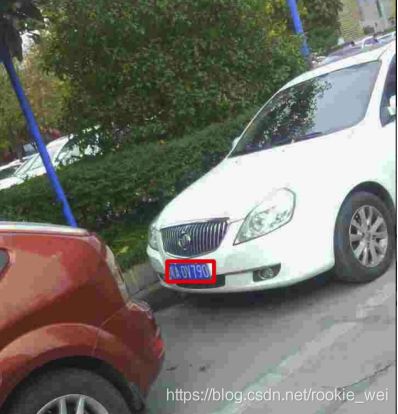TensorFlow入门教程(28)车牌识别之使用EAST模型进行车牌检测(四)
#
#作者:韦访
#博客:https://blog.csdn.net/rookie_wei
#微信:1007895847
#添加微信的备注一下是CSDN的
#欢迎大家一起学习
#
1、概述
上一讲,我们实现了EAST的代码,但是我们使用的是ICDAR2017数据集,实现的是对自然场景下的文本检测,现在,我们在原来的代码的基础上,来实现针对车牌的检测。
环境配置:
操作系统:Ubuntu 64位
显卡:GTX 1080ti
Python:Python3.7
TensorFlow:2.3.0
2、CCPD2019数据集
下载链接: https://github.com/detectRecog/CCPD
CCPD2019是中科大开源的数据集,用于车牌检测以及识别的任务。数据集包含了远/近距离、水平/倾斜角度、不同光照、不同天气等等的包含车牌的照片。但是它也有很多缺陷,比如,大部分都是皖A车牌,都是7位数的燃油车牌,没有新能源车牌等等,不过作为学习使用也够了。
下载解压数据集后,得到如下所示文件夹,
其中,ccpd_开头的文件夹下都是图片数据,splits文件夹下则是文本文件。splits文件夹如下图所示,
随便打开一个文本看看,如下图所示,
可以看到,ccpd_blur.txt文件里的每一行都指向ccpd_blur文件夹下的一个图片文件,其他的也是类似的。
CCPD车牌坐标等信息是直接写在文件名里,格式如下,
info1-info2-info3-info4-info5-info6-info7.jpg
其含义如下,
info1:地域area
info2:倾斜程度Tilt degree
info3:标注框坐标Bounding box coordinates
info4:四个车牌顶角坐标Four vertices locations
info5:车牌号码License plate number
info6:车牌区域亮度信息Brightness
info7:车牌区域模糊程度Blurriness
我们写个代码来分别根据标注框坐标和顶点坐标画出车牌框,代码如下,
import cv2
import numpy as np
import csv
import os
def line(image, polys, color=(0,0,255)):
image = cv2.line(image, tuple(polys[0]), tuple(polys[1]), color, thickness=5)
image = cv2.line(image, tuple(polys[1]), tuple(polys[2]), color, thickness=5)
image = cv2.line(image, tuple(polys[2]), tuple(polys[3]), color, thickness=5)
image = cv2.line(image, tuple(polys[3]), tuple(polys[0]), color, thickness=5)
return image
def get_polys(image_file):
polys = []
print("image_file:", image_file)
if not os.path.exists(image_file):
return np.array(polys, dtype=np.float32)
parts = image_file.split("-")
polys_part = parts[3].split("_")
print(polys_part)
poly = []
for p in polys_part:
poly.append(p.split("&"))
polys.append(np.asarray(poly).astype(np.int32))
print("polys:", polys)
return polys
def get_rectangle(image_file):
polys = []
print("image_file:", image_file)
if not os.path.exists(image_file):
return np.array(polys, dtype=np.float32)
parts = image_file.split("-")
rect_part = parts[2].split("_")
poly = []
for p in rect_part:
poly.append(p.split("&"))
poly = np.asarray(poly).astype(np.int32)
polys.append([poly[0], [poly[1][0], poly[0][1]], poly[1], [poly[0][0], poly[1][1]]])
print(polys)
return polys
def show(filename):
rects = get_rectangle(filename)
polys = get_polys(filename)
image = cv2.imread(filename)
for rect in rects:
print("rect:", rect)
image = line(image, rect, (0,0,255))
for poly in polys:
print("poly:", poly)
image = line(image, poly, (255,0,0))
image = cv2.resize(image, (512, 512))
cv2.imshow("demo1", image)
cv2.imwrite("demo1.jpg", image)
cv2.waitKey(0)
show("ccpd_blur/0359-5_21-151&285_417&398-417&398_179&377_151&285_389&306-0_0_4_33_32_25_12-59-4.jpg")运行结果,
3、修改代码
现在,我们基于上一讲的代码来修改。
3.1导入坐标
显然,数据集中使用车牌4个顶点坐标更适合我们的EAST算法,根据文件名获取车牌4个顶点坐标的代码如下,
'''
ccpd数据集的坐标等信息直接在文件名中,所以解析文件名即可拿到坐标信息
'''
def load_ccpd_polys(filename):
text_polys = []
ignored_label = []
parts = filename.split("-")
polys_part = parts[3].split("_")
poly = []
for p in polys_part:
poly.append(p.split("&"))
text_polys.append(np.asarray(poly).astype(np.int32))
ignored_label.append(False)
# print(text_polys)
return np.array(text_polys, dtype=np.float32), np.array(ignored_label, dtype=np.bool)3.2、导入数据集并创建tf.data.Dataset
数据增强的代码跟上一讲中类似,代码如下,
def parse_func(image_file, FLAGS):
[image, score_map, geo_map] = tf.py_function(lambda image_file: preprocess(image_file, FLAGS=FLAGS), [image_file], [tf.float32, tf.float32, tf.float32])
return image, score_map, geo_map
class CCPD2019_Dataset:
def __init__(self, FLAGS):
self.FLAGS = FLAGS
ccpd_train_dir = os.path.join(FLAGS.ccpd_dataset_dir, FLAGS.ccpd_train_txtfile)
ccpd_valid_dir = os.path.join(FLAGS.ccpd_dataset_dir, FLAGS.ccpd_valid_txtfile)
assert os.path.exists(ccpd_train_dir) and os.path.exists(ccpd_valid_dir)
self.train_filelist = get_iamges_from_txt(FLAGS.ccpd_dataset_dir, ccpd_train_dir)
self.valid_filelist = get_iamges_from_txt(FLAGS.ccpd_dataset_dir, ccpd_valid_dir)
assert len(self.train_filelist) > 0 and len(self.valid_filelist) > 0
# 如果有ICDAR数据集,那么将该数据集也加入训练,让其全部当背景图,这样模型对不是车牌的字符能更好的判断
if os.path.exists(FLAGS.icadr_dataset_dir) and os.path.exists(FLAGS.icadr_dataset_dir):
icadr_train_dir = os.path.join(FLAGS.icadr_dataset_dir, "ch8_training_images")
icadr_valid_dir = os.path.join(FLAGS.icadr_dataset_dir, "ch8_validation_images")
assert os.path.exists(icadr_train_dir) and os.path.exists(icadr_valid_dir)
icadr_train_filelist = get_images_from_dir(icadr_train_dir)
icadr_valid_filelist = get_images_from_dir(icadr_valid_dir)
assert len(icadr_train_filelist) > 0 and len(icadr_valid_filelist) > 0
self.train_filelist.extend(icadr_train_filelist)
self.valid_filelist.extend(icadr_valid_filelist)
self.train_filelist = np.asarray(self.train_filelist)
self.valid_filelist = np.asarray(self.valid_filelist)
np.random.shuffle(self.train_filelist)
np.random.shuffle(self.valid_filelist)
def create_dataset(self, subset):
if subset == "train":
filelist = self.train_filelist
else:
filelist = self.valid_filelist
ds = tf.data.Dataset.from_tensor_slices(filelist)
ds = ds.map(lambda image_file: parse_func(image_file, FLAGS=self.FLAGS))
ds = ds.batch(self.FLAGS.batch_size)
ds = ds.prefetch(AUTOTUNE)
return ds从代码中可以看到,如果存在ICDAR数据集,最好将它也加入训练,这样模型能对非车牌的字符能有更好的判断,只用CCPD数据集的话,对于一些不是车牌的字符,模型可能误认为它是车牌的。
3.2、preprocess
因为同时使用两个数据集,所以preprocess函数也要微改一下,代码如下,
def preprocess(image_file, FLAGS, is_test=False):
# start = time.time()
# print("------start------------")
# print(image_file)
if not is_test:
# tf.data.Dataset需要这样转换一下才能用
image_file = image_file.numpy().decode("utf-8")
if FLAGS.task == "plate":
_,filename = os.path.split(image_file)
if filename.startswith("img_"):
# icdar数据集的数据
polys = []
ignored_labels = []
else:
# ccpd数据集
polys, ignored_labels = load_ccpd_polys(image_file)
else:
polys, ignored_labels = load_icdar_polys(image_file)
# print("load_icdar_polys time: ", time.time() - start)
image = cv2.imread(image_file)
image, polys = random_scale_image(image, polys)
# print("random_scale_image time: ", time.time() - start)
image, polys, ignored_labels = random_crop_area(FLAGS, image, polys, ignored_labels)
# print("random_crop_area time: ", time.time() - start)
image, polys = pad_image(image, polys, FLAGS.input_size)
# print("pad_image time: ", time.time() - start)
image, polys = resize(image, polys, FLAGS.input_size)
# print("resize time: ", time.time() - start)
score_map, geo_map = map_generator(FLAGS, image, polys, ignored_labels)
image = (image / 127.5) - 1
# print("map_generator time: ", time.time() - start)
return image, score_map[::4, ::4, np.newaxis], geo_map[::4, ::4]其他部分的代码就基本一致了。然后就开始训练即可。
4、验证模型
运行eval.py文件,可以看到我们训练好的模型的运行效果,如下图所示,
可以看到,不管是水平的还是斜的车牌,都能准确识别出来了,而且,对于不是车牌的文字,它也不会误当车牌。
5、完整代码
https://mianbaoduo.com/o/bread/YZWcl5tw






